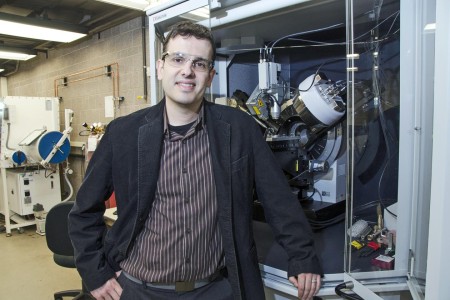Apr
23
Can Magnesium Ion Upgrade Lithium Ion Batteries?
April 23, 2015 | 3 Comments
University of Illinois at Chicago (UIC) researchers have shown they can replace the lithium ions, each of which carries a single positive charge, with magnesium ions, which have a plus-two charge, in battery-like chemical reactions. Moreover the team used an electrode with a structure like those in many of today’s devices.
The work is a significant step forward in developing a battery that could outperform the lithium-ion technology used today.
Jordi Cabana, UIC assistant professor of chemistry and principal investigator on the study explains how this advance works, “Because magnesium is an ion that carries two positive charges, every time we introduce a magnesium ion in the structure of the battery material we can move twice as many electrons. We hope that this work will open a credible design path for a new class of high-voltage, high-energy batteries.”

Jordi Cabana, UIC assistant professor of chemistry. Image Credit: Joshua Clark. Click image for the largest view.
The research is part of the Joint Center for Energy Storage Research, a Department of Energy Innovation Hub led by Argonne National Laboratory, that aims to achieve revolutionary advances in battery performance. The study paper is online in advance of print in the journal Advanced Materials.
This battery technology consists of a positive and negative electrode and an electrolyte. The electrodes exchange electrons and ions, which are usually of positive charge. Only the ions flow through the electrolyte. Because the electrolyte is also an electric insulator that forces the electrons to flow through the external circuit to power a device or vehicle.
To recharge the battery, the ion exchange is reversed. But the chemical reaction is not perfectly efficient, which limits how many times the battery can be recharged.
Cabana takes up the explanation again, “The more times you can do this back and forth, the more times you will be able to recharge your battery and still get the use of it between charges. In our case, we want to maximize the number of electrons moved per ion, because ions distort the structure of the electrode material when they go in or leave. The more the structure is distorted, the greater the energy cost of moving the ions back, the harder it becomes to recharge the battery.”
“Like a parking garage, there are only so many spaces for the cars,” Cabana said. “But you can put a car in each space with more people inside without distorting the structure.”
Having established that magnesium can be reversibly inserted into electrode material’s structure brings us one step closer to a prototype, said Cabana.
“It’s not a battery yet, it’s piece of a battery, but with the same reaction you would find in the final device,” said Cabana.
It is way early in this development. So far the UIC team has shown the magnesium ions can lodge into the electrodes strongly hinting that the total electrons in an equivalent battery dimension may well be about double. Its not revealed how many times the discharge recharge cycle can be made. But the hints suggest that they’re hoping for an electrolyte that insulates well enough that the circuit voltage is high.
Congratulations are in order. But, there is a very long way to go. Lets hope the funding follows for this research field to continue on.
Comments
3 Comments so far


The caveat that comes to mind immediately is that Magnesium burns like a sonofagun!
With all the battery fires that have been reported with lithium – I wonder if substituting magnesium might be a dangerous idea.
Matt,
Please advise the quantity of what
“All the Battery Fires”means?
Then compare that with “All the ICE Gasoline Fires”.
Personally,
I would like to see what the energy & power density,
# recharge cycles and recharge times look like when compared to Lithium ion tech.
isn’t magnesium heavier than lithium?
So the energy density of a magnesium battery should be less than twice the one a lithium battery, Am I wrong?